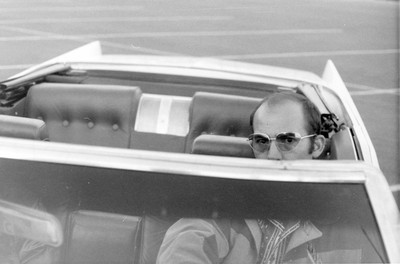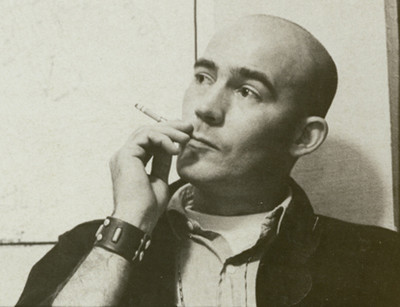‘Gonzo’
As somebody (I forget who) once said, those who claim to remember the '60s weren't really there.
As somebody else (poet-philosopher George Santayana) said, "Those who cannot remember the past are condemned to repeat it."
Both seemingly contradictory statements popped into my head, repeatedly, while watching "Gonzo" reel in the years.
Subtitled "The Life and Work of Dr. Hunter S. Thompson," this documentary (which returns to Las Vegas following its local debut at June's CineVegas film festival) revisits the curious case of the self-styled gonzo journalist who gave the world, among other indelible works, "Fear and Loathing in Las Vegas."
Oscar-winning documentarian Alex Gibney ("Taxi to the Dark Side") has come to praise Thompson, not to bury him. (That happened following Thompson's 2005 suicide.)
Yet there's an inescapable undercurrent of what might have been -- if Thompson had been able to continue his groundbreaking career as a sardonic, shoot-from-the-hip chronicler of our strange days without surrendering to the strangeness within.
Because, as "Gonzo" reminds us, there was a time when Thompson's work captured, as no one else's did, the contradictions that helped make the '60s and early '70s such a revolutionary time in American history.
While covering such outsized, crazed times, Thompson invented an outsized, crazed persona for himself -- and eventually succumbed to it.
Those who attended another Thompson documentary -- "Breakfast With Hunter," which is excerpted in "Gonzo" -- at 2003's CineVegas undoubtedly recall the freak show surrounding the author's first Sin City overnight since the drug-fueled days of "Fear and Loathing in Las Vegas." Beset by back problems, he was a no-show at a panel discussion, but made it to the screening by riding through the Palms aboard a golf cart, accompanied by two costumed showgirls -- who carried him into the theater and deposited him in his seat. (At that night's CineVegas party, Thompson was seen hitting people with his cane.)
It was vintage Thompson: outrageous, indulgent and exactly what everyone expected from him.
As "Gonzo" makes painfully clear, however, it wasn't necessarily what Thompson wanted. At least not at first.
Initially, he wanted to hone his craft as a writer -- but he went about it a bit differently than his predecessors.
Along with Tom Wolfe, Gay Talese and others, Thompson pioneered "new" journalism (Thompson's word for it was "gonzo"), a subjective style that applied fictional techniques to factual material.
It might not have been strictly accurate, according to traditional journalistic standards, but it certainly could capture the truth and not just the photo-op, sound bite-heavy "truthiness" that holds sway in today's media-saturated world.
Thompson's account of riding with a motorcycle gang marked his emergence as a provocative new voice -- and the published author of "Hell's Angels: A Strange and Terrible Saga." (It's a hoot watching him face off with panelists Kitty Carlisle and Peggy Cass on the celebrity quiz show "To Tell the Truth.")
From there, Thompson found his way to a new weekly, Rolling Stone, that reflected a-changin' times, from flower power to Vietnam. And, of course, to the savage journey to the heart of the American dream that became "Fear and Loathing in Las Vegas." (Clips from the 1998 movie version, featuring Johnny Depp as Thompson, turn up in "Gonzo" -- as does Depp, who reads from Thompson's collected works.)
Along with vintage footage, "Gonzo" gathers recollections from those who shared his public and private lives. (Often, they were one in the same.)
From Jimmy Buffett to Jimmy Carter, from Republican politico Pat Buchanan to Democratic pollster Pat Caddell, talking heads bring Thompson to light.
Bringing Thompson to life, however, are such friends and co-conspirators as illustrator Ralph Steadman and Rolling Stone editor Jann Wenner. And Thompson's first wife, Sandy, counters some of Thompson's more adoring defenders while pointing out his ultimate inability to keep fighting the good fight.
Throughout, Gibney (whose credits also include "Enron: The Smartest Guys in the Room") keeps his cinematic collage in motion, often making striking visual connections. In one vivid example, Thompson works at his typewriter while 9/11 footage unspools before him on a window transformed into a video screen.
And if the inevitable use of period-perfect music occasionally seems too obvious (Steadman recalls his first mescaline trip as "Goin' Out of My Head" cranks up), it nevertheless reminds us that the era's sounds often were as -- if not more -- important than its sights.
Inevitably, Gibney gets bogged down on this long, strange trip. That's especially true during the extended "Fear and Loathing on the Campaign Trail '72" sequence, when "Gonzo" threatens to metamorphose from a documentary about Thompson to one about the Richard Nixon-George McGovern campaign. (Although it's chilling to hear how timely McGovern's anti-war speeches still seem if you substitute "Iraq" for "Vietnam.")
Yet despite its occasional flaws, "Gonzo" provides a provocative -- and timely -- reminder of a time when people and their politics were indivisible, and liberty and justice (as defined by the author) were the point.
Contact reporter Carol Cling at ccling@reviewjournal.com or 702-383-0272.
REVIEW Movie: "Gonzo" Running Time: 118 minutes Rating: R; drug and sexual content, nudity, profanity Verdict: B Now Playing: Village Square DEJA VIEW Buy the ticket, take the ride and explore the wild world of Hunter S. Thompson through these titles: "Where the Buffalo Roam" (1980) -- "I hate to advocate weird chemicals, alcohol, violence or insanity to anyone... but they've always worked for me." That was the tagline for this semi-autobiographical comedy featuring Bill Murray as Thompson and Peter Boyle as his attorney. "Fear and Loathing in Las Vegas" (1998) -- Johnny Depp (as Thompson alter ego Raoul Duke) and Benicio Del Toro (as attorney Oscar Acosta) hit the psychedelic trail in director Terry Gilliam's trippy adaptation, which was filmed partially on location -- and features, among others, Tobey Maguire, Ellen Barkin, Cameron Diaz, Christina Ricci, Mark Harmon and Las Vegas' own Penn Jillette and Steve Schirripa in the supporting cast. "Breakfast With Hunter" (2003) -- Some 18 years in the making, director Wayne Ewing's documentary focuses on Thompson's life in Aspen, Colo., where a steady stream of famous folk (including Depp and John Cusack) pay homage -- and witness Thompson's predictably outrageous behavior. -- By CAROL CLING
















